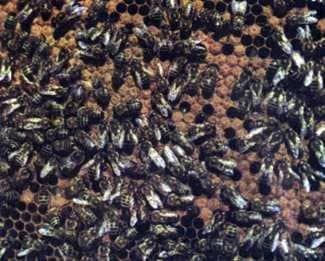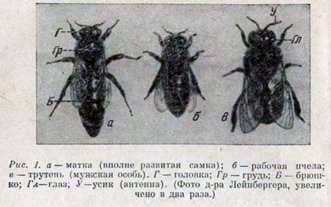
A nature lover has two possibilities to start acquaintance with bees: walking on a warm spring or summer day through a flowering garden or a fragrant meadow, he will see bees energetically working on flowers; he can pass also past the apiary of some beekeeper and look at the bees that fly out of their homes and return to them. There can be a dozen or more, or even more than a hundred hives with bees. If desired, the beekeeper can limit himself to a single hive.
But he must have at least a “beehive hive”, or “bee family”, which consists of many thousands of individuals. A peasant may have one cow, one dog and even one chicken, but it is impossible to keep a single bee – it will very soon die. However, this is not at all a matter of course, on the contrary, this peculiarity of bees is amazing.
If we turn to the distant relatives of our bees, to other insects, it turns out that such a social way of life is not peculiar to everyone. We will see that in moths, beetles, dragonflies and other insects males and females converge for a short time for mating, and then again part, and then each of them goes its own way.
Females lay eggs in a place where the young can find food, but they do not care for them and do not even know them. After laying eggs, the females no longer worry about their offspring; Before the brood emerges from the eggs, the mother is in most cases already dead. Why are bees so dependent on each other that they can not live separately, but only families? And what is a “bee family” in general?
Suppose that one evening, when all the flying bees return home, our nature lover will bring a beehive into the room, open it and spread all the contents on the table, – how many bees will be presented to his gaze? If he takes the trouble to count them, and the family chosen by him will not turn out to be weak, then he will find here from 40 to 70 thousand bees. The number of family members corresponds to the number of inhabitants of the average city, for example, such as Beirut or Erlangen. This number does not include the “children” of the bee family. With them, the situation is special – they are not so easy to detect. Let us, therefore, start with older bees.

At first glance, they all seem to be the same. The body of each individual is clearly divided into three parts: a head with two large eyes on each side, a mouth underneath and two antennae. These antennae are present in all insects and are especially well developed in beetles-beetles (or lumberjacks), who in childhood gave us, boys, much joy. On the chest, from the sides are two pairs of wings, and below – three pairs of legs. A thin waist connects the breast with a segmented abdomen.
However, with closer examination between the individual members of the bee family, differences are found. One of the bees stands out among his fellow hives with his long and slender belly. Beekeepers call it a womb: the fate of the family primarily depends on it, because it is the only fully developed female in the “bee state”, the only mother of a huge family.
Other bees, differing in their thick, awkward body and especially large eyes, are found in a somewhat larger number – they are males, drones. They live in the family only in the spring and early summer. Later they become useless, and “fellow citizens” by the beehive force expel them. Therefore, we would waste time in search of drones in autumn and winter. The rest of the family are working bees; they make up the bulk of the hive population. Working bees are females, but they do not lay eggs. It is this property, which is most pronounced in the uterus and in other female insects, in worker bees is in a depressed state.
But the maternal instinct of caring for the offspring, manifested in feeding the baby and caring for her, on the contrary, is developed unusually for insects. The uterus, who has no inclination for this work, has completely freed from worries about the upbringing of a new generation. So, the uterus lays eggs, and the worker bees take care of them.
Working bees also care about the cleanliness of the hive – they remove garbage and bee corpses, build housing, maintain the appropriate temperature in the hive, protect their dwelling when it becomes necessary, extract and distribute food, in a word, perform all work that neither womb, or drones.
Thus, in a bee family, everyone depends on one another and no one can live alone.
Щавелевая кислота для пчеловодства. Улья павильоны.
The bee family and its composition